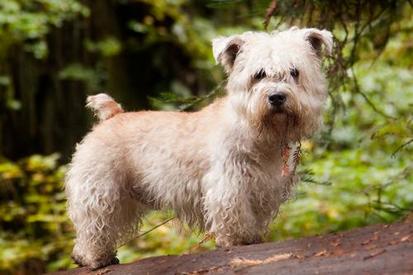
A breed of Irish descent, the exact origin of the Glen of Imaal Terrier is unknown, yet many believe it was developed from dogs brought to Ireland's Wicklow Mountains by Flemish mercenary soldiers in the 1570s. After breeding with the native dogs, which were usually Terriers, the Glen of Imaal Terrier came into existence and remains today the least known of the Irish dog breeds. Originally utilised in hunting fox, badger and vermin, the Glen of Imaal Terrier became a popular working dog in its native County Wicklow, but was nearly lost during WWII along with many breeds; after 30 years, the Glen of Imaal Terrier was revived, however numbers remain low. Presented at an Irish dog show in 1933, a year before it was officially recognised by the Irish Kennel Club.
Distinctive in appearance, the breed combines the low to the ground, short-limbed stature of popular French breeds such as the Basset Fauve De Bretagne, and the rough-haired, wheaten-coloured semblance of the Terrier. The Glen of Imaal is further characterised by a tapering muzzle, bowed legs, wide-set ears and a harsh coat in colour variations of cream, wheaten, blue, brindle or tan. Despite being an illegal practice in most European countries, tail 'docking' is common with this breed, although this is not a breed standard. The Glen of Imaal's bowed front legs were thought to offer a 'mechanical advantage' when digging and carrying out other working fulfillments.
Fiercely devoted to its family, the breed is mellow and mannered within the home, although it has been said that the Glen of Imaal takes longer to mature than other dogs. This might be translated through boisterousness, disobedience or stubbornness, so consistent training from an early age is essential. When trained, the Glen of Imaal Terrier has the potential to be a very companionable dog, obedient to instruction and vigilant to change and threat, rendering it an ideal guard dog. On average, a healthy Glen of Imaal will weigh 15-16 kg, with a life expectancy of 13-14 years. It is not uncommon for the breed to outlive this expectancy.
Typically healthy, long-lived and resilient, the Glen of Imaal Terrier is prone to a variety of genetic diseases, mainly associated with the eyes; there are many documented cases of progressive retinal atrophy in the breed, as well as rod-cone dystrophy. Other breed-specific ailments include skin allergies and hip dysplasia, although this can be seen across breeds.
Do you own a Glen of Imaal Terrier? Let others know what they're like!
Related products
Advantage 80 Spot On Flea Control Large Cats and Rabbits
from £12.95
Advantage 40 Spot On Flea Control Cats, Small Dogs and Rabbits
from £12.95
Advantage 100 Spot On Flea Control Medium Dog
from £12.95
Advantage 250 Spot On Flea Control Large Dog
from £12.95
Drontal Tasty Bone Wormer Tablets for Small & Medium Dogs (2 to 20kg)
from £1.83
FRONTLINE Plus Flea & Tick Treatment Dogs & Cats
from £17.49
TermaWorm™ Tablets for Cats & Dogs
from £1.59
Drontal Tasty Bone XL Wormer Tablets for Large Dogs (Over 20kg)
from £5.43